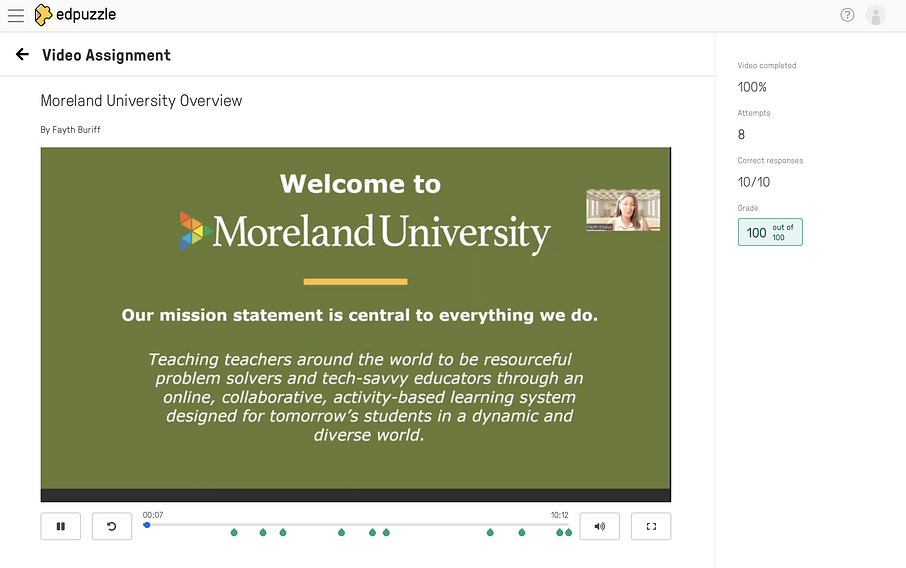ED 501
- How can the Edpuzzle you completed in the previous assignment guide you as you progress through this program? This can help me navigate the system to be successful in completing my assignments and understanding where resources are to complete my courses.
- How can the information you discovered in the Course Catalog and Candidate Handbook guide you as you progress through this program?
- Program Structure and Requirements: The Course Catalog provides me with a clear map of the teacher certification program's structure. It outlines the specific requirements I must fulfill, including the total number of credits, core courses, and any specialization or elective options available. This foundational information ensures I have a solid understanding of the program's framework and expectations.
- Course Selection: Within the Course Catalog, I find detailed descriptions of each course offered in the program. These descriptions include prerequisites and corequisites, helping me make informed decisions about which courses to take. By carefully selecting courses that align with my interests and program requirements, I can optimize my learning experience.
- Sequencing and Scheduling: The Course Catalog often provides guidance on the recommended sequence of courses. This invaluable guidance assists me in creating a well-structured course schedule, ensuring I progress through the program in a logical and efficient manner. Understanding which courses to tackle in each semester is critical for my timely completion.
- Specializations and Electives: Should the program offer specialization tracks or elective courses, the Catalog furnishes me with insights into these options. This flexibility allows me to explore areas of personal interest, contemplate concentrations, and customize my educational journey to align with my career aspirations.
- Graduation Requirements: The Catalog serves as a repository of information regarding the specific requirements for graduation from the program. It delineates factors such as the total credit count, mandatory exams or assessments, and any other criteria essential for obtaining my teaching certification.
- Academic Policies: Both the Course Catalog and Candidate Handbook house crucial academic policies and procedures. These encompass a range of topics, including grading criteria, attendance expectations, academic integrity guidelines, and program-specific policies. Familiarity with these policies is essential to my academic success.
- Certification Pathway: The Candidate Handbook, in particular, offers a roadmap detailing the steps and prerequisites for achieving my teaching certification. This comprehensive guide covers crucial elements such as student teaching, the certification exam process, and any additional requirements imposed by the state or the university.
- Support Services: I've discovered that these resources also highlight the availability of support services designed to aid students in their academic journey. These services, which may include tutoring, academic advising, and career counseling, are valuable lifelines to help me navigate the program effectively.
- Important Dates: Both the Course Catalog and Candidate Handbook furnish academic calendars replete with vital dates, including registration deadlines, semester commencement and conclusion dates, and exam schedules. Staying abreast of these dates is indispensable for meticulous planning of my academic and personal commitments.
- Professional Development: I've learned that some programs offer insight into professional development opportunities, conferences, and networking events. Armed with this knowledge, I can actively engage in activities that enhance my teaching skills and keep me abreast of advancements in the education field.
- How can the InTASC Standards and Clinical Rubric guide you as you progress through this program?
- Clear Expectations: As a teacher candidate, the InTASC Standards serve as a beacon, illuminating the essential knowledge, skills, and professional dispositions that I need to develop. These standards offer a clear roadmap for my journey through the program, helping me understand what's expected of me as a future educator.
- Self-Assessment and Growth: The Clinical Rubric is like a mirror reflecting my teaching practice. It breaks down the InTASC Standards into concrete behaviors and competencies. Through regular self-assessment using the rubric, I can gauge my progress and pinpoint areas where I excel and areas where I need improvement. This self-awareness is a crucial part of my professional growth.
- Constructive Feedback: One of the most valuable aspects of the Clinical Rubric is the feedback it provides from experienced educators and supervisors. Their observations and evaluations, based on the rubric, help me understand how I'm performing in real classroom settings. This feedback is specific, actionable, and focused on helping me improve as a teacher.
- Alignment with Coursework: The InTASC Standards ensure that my coursework is directly aligned with what I need to be an effective teacher. I can see the direct connection between what I'm learning in my courses and the expectations outlined in the standards. This alignment reinforces the practical relevance of my education.
- Professional Preparedness: Embracing the InTASC Standards and the Clinical Rubric isn't just about meeting program requirements; it's about preparing myself to be a competent and ethical educator. By following these guidelines, I'm not only setting myself up for success in the classroom but also demonstrating my commitment to the profession and my students.
- Long-Term Growth: Education is a dynamic field that continually evolves. The InTASC Standards, periodically updated to reflect best practices, remind me that my growth doesn't stop after I earn my teaching credentials. I must continue to align my practice with these evolving standards to remain effective throughout my teaching career.
- Professional Accountability: Using the InTASC Standards and Clinical Rubric showcases my commitment to being a responsible and accountable teacher. These tools help me track my progress, prove my readiness for licensure, and demonstrate my dedication to meeting the expectations of my future school district and students.

